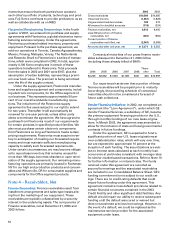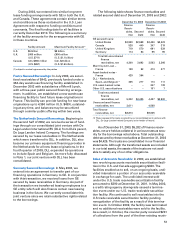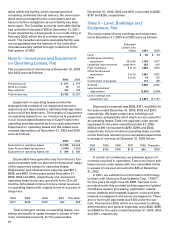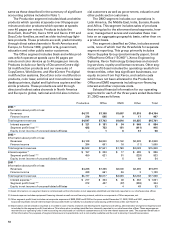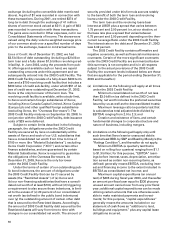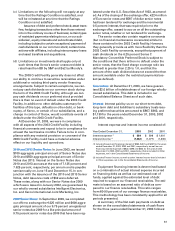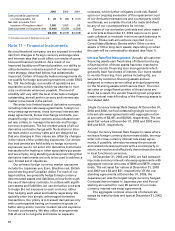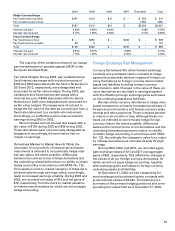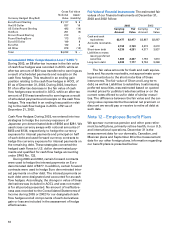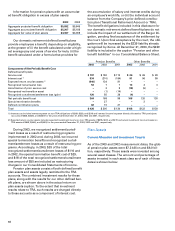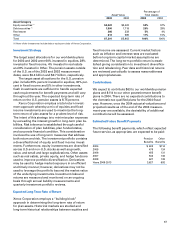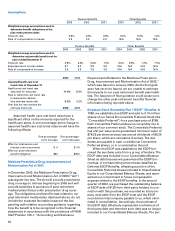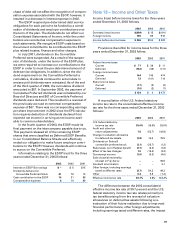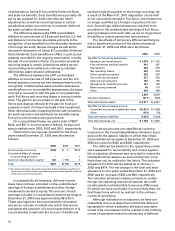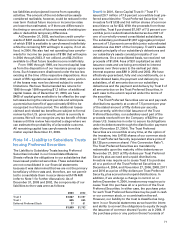Xerox 2003 Annual Report Download - page 64
Download and view the complete annual report
Please find page 64 of the 2003 Xerox annual report below. You can navigate through the pages in the report by either clicking on the pages listed below, or by using the keyword search tool below to find specific information within the annual report.
62
2003 2002 2001
Cash proceeds (payments)
on notes payable, net $ 22 $ (33) $ (141)
Net cash proceeds from
issuance of long-term debt (1) 1,580 1,053 89
Cash payments on long-term debt (5,646) (5,639) (2,396)
$(4,044) $(4,619) $(2,448)
(1) Includes payment of debt issuance costs.
Note 11 – Financial Instruments
As a multinational company, we are exposed to market
risk from changes in foreign currency exchange rates
and interest rates that could affect our results of opera-
tions and financial condition. As a result of our
improved liquidity and financial position, our ability to
utilize derivative contracts as part of our risk manage-
ment strategy, described below, has substantially
improved. Certain of these derivative arrangements do
not qualify for hedge accounting treatment under SFAS
No. 133. Accordingly, our results of operations are
exposed to some volatility, which we attempt to mini-
mize or eliminate whenever possible. The level of
volatility will vary with the level of derivative hedges
outstanding, as well as the currency and interest rate
market movements in the period.
We enter into limited types of derivative contracts,
including interest rate swap agreements, foreign cur-
rency swap agreements, cross currency interest rate
swap agreements, forward exchange contracts, pur-
chased foreign currency options and purchased inter-
est rate collars, to manage interest rate and foreign
currency exposures. The fair market values of all our
derivative contracts change with fluctuations in inter-
est rates and/or currency rates and are designed so
that any changes in their values are offset by changes
in the values of the underlying exposures. Our deriva-
tive instruments are held solely to hedge economic
exposures; we do not enter into derivative instrument
transactions for trading or other speculative purposes
and we employ long-standing policies prescribing that
derivative instruments are only to be used to achieve a
very limited set of objectives.
Our primary foreign currency market exposures
include the Japanese yen, Euro, Brazilian real, British
pound sterling and Canadian dollar. For each of our
legal entities, we generally hedge foreign currency
denominated assets and liabilities, primarily through
the use of derivative contracts. In entities with signifi-
cant assets and liabilities, we use derivative contracts
to hedge the net exposure in each currency, rather
than hedging each asset and liability separately. We
typically enter into simple unleveraged derivative
transactions. Our policy is to transact derivatives only
with counterparties having an investment-grade or
better rating and to monitor market risk and exposure
for each counterparty. We also utilize arrangements
that allow us to net gains and losses on separate
contracts, which further mitigates credit risk. Based
upon our ongoing evaluation of the replacement cost
of our derivative transactions and counterparty credit
worthiness, we consider the risk of a material default
by any of our counterparties to be remote.
Some of our derivative contracts and other materi-
al contracts at December 31, 2003 require us to post
cash collateral or maintain minimum cash balances in
escrow. These cash amounts are reported in our
Consolidated Balance Sheets within Other current
assets or Other long-term assets, depending on when
the cash will be contractually released (see Note 1).
Interest Rate Risk Management: Virtually all customer-
financing assets earn fixed rates of interest and a sig-
nificant portion of those assets has been matched to
secured vendor financing loan arrangements which
generally bear fixed rates of interest. Our loans related
to vendor financing, from parties including GE, are
secured by customer-financing assets and are
designed to mature as we collect principal payments
on the financing assets which secure them. The inter-
est rates on a significant portion of those loans are
fixed. As a result, the vendor financing loan programs
create natural match-funding of the financing assets to
the related debt.
Single Currency Interest Rate Swaps: At December 31,
2003 and 2002, we had outstanding single currency
interest rate swap agreements with aggregate notion-
al amounts of $2,491 and $3,820, respectively. The net
asset fair values at December 31, 2003 and 2002 were
$46 and $121, respectively.
Foreign Currency Interest Rate Swaps: In cases where
we issue foreign currency-denominated debt, we may
enter into cross-currency interest rate swap agree-
ments, if possible, whereby we swap the proceeds
and related interest payments with a counterparty. In
return, we receive and effectively denominate the debt
in local functional currencies.
At December 31, 2003 and 2002, we had outstand-
ing cross-currency interest rate swap agreements with
aggregate notional amounts of $696 and $879, respec-
tively. The net asset fair values at December 31, 2003
and 2002 were $4 and $21, respectively. Of the out-
standing agreements at December 31, 2003, the
Japanese yen was the largest single currency hedged.
Contracts denominated in Japanese yen and Pound
sterling accounted for over 95 percent of our cross-
currency interest rate swap agreements.
The aggregate notional amounts of interest rate
swaps by maturity date and type at December 31, 2003
follow:


